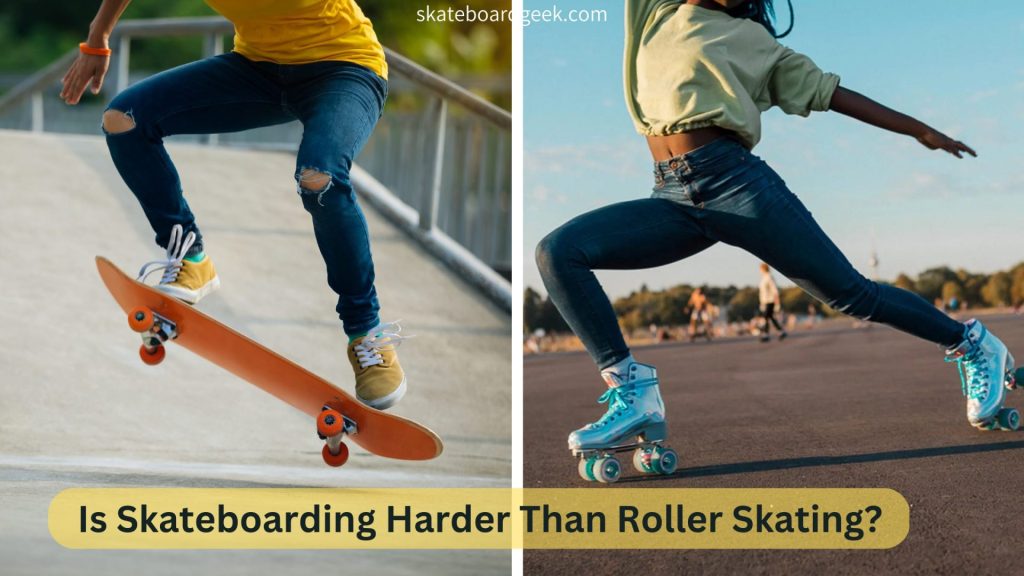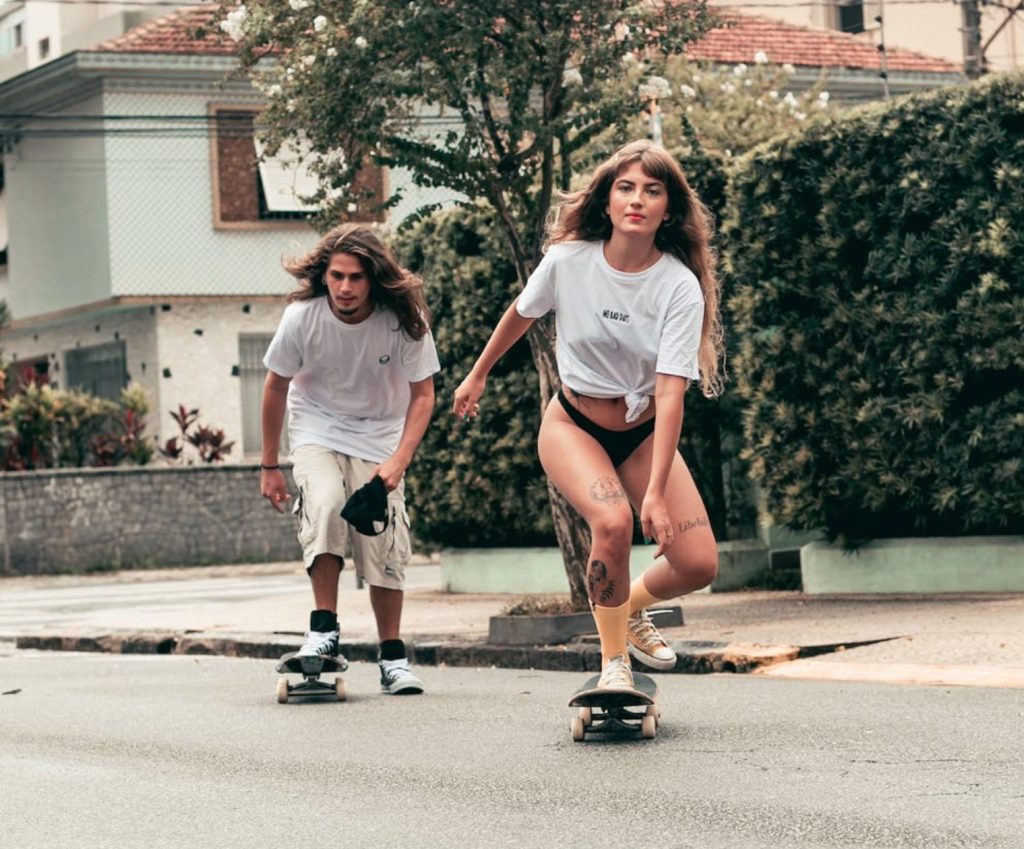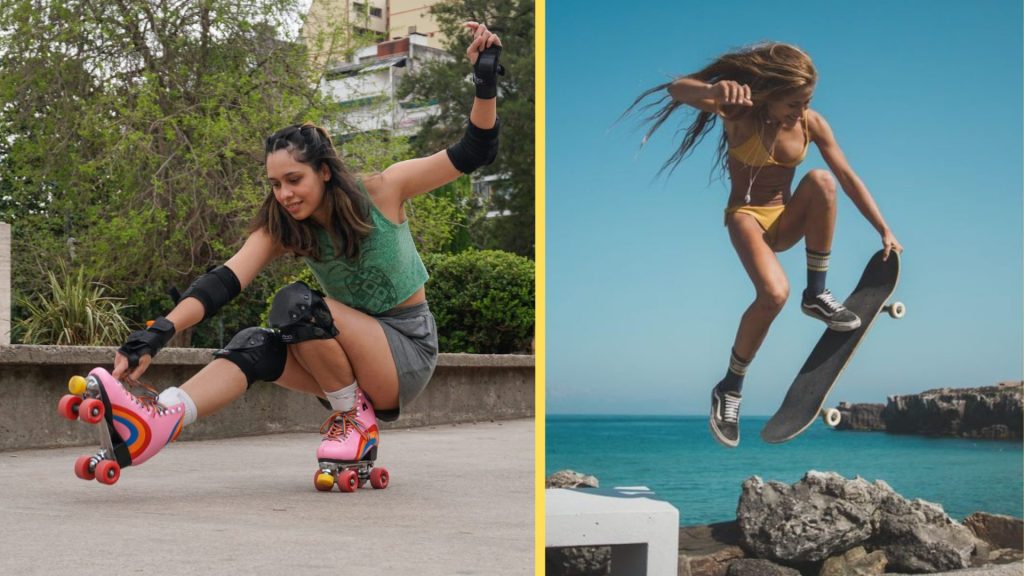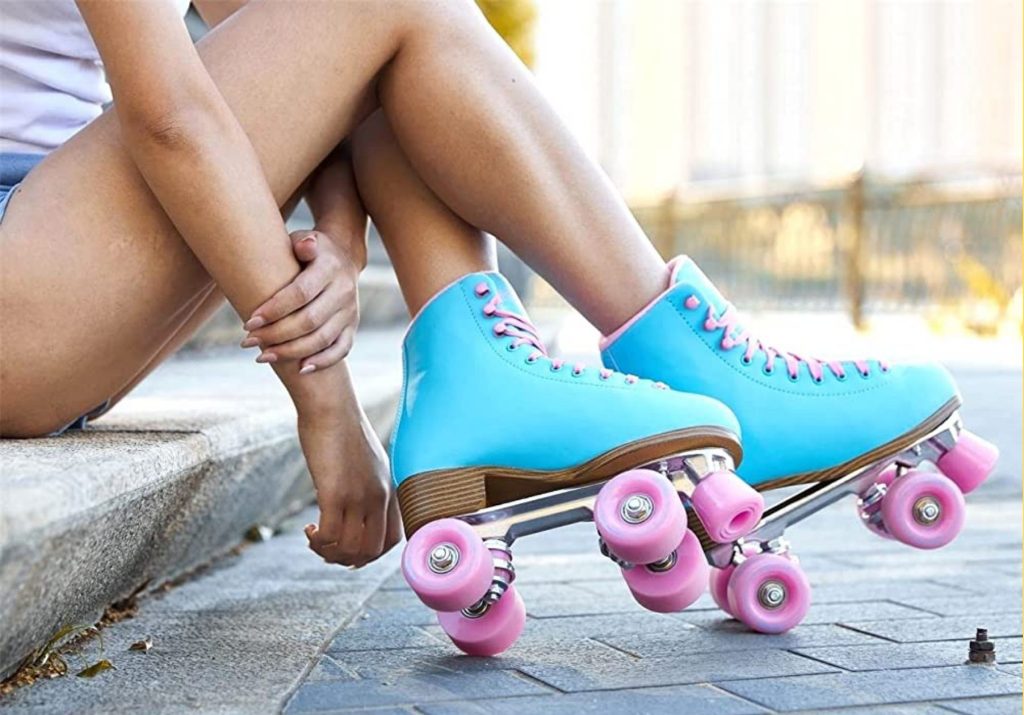Are you feeling stuck between skateboarding vs. roller skating as your next adrenaline-filled hobby? Well, the question that troubles most beginners is, which one is harder? Is it skateboarding or roller skating?
As someone who has had their fair share of falls and bruises in both sports, let me tell you, I found skateboarding harder than roller skating for a new skater.
Here, we’ll explore the differences between the two and weigh in on which one might be considered more challenging, and help you make an informed decision on which sport to pursue.
Contents
- Is Skateboarding Harder Than Roller Skating? All You Need to Know
- Additional Comparison of Skateboarding vs. Roller Skating
- 1. Skating Gear and Equipment: Similarities and Differences
- 2. Skateboard and Roller Skate Design
- 3. Skating Surfaces and Their Impact on Skating
- 4. Muscles Involved in Skating and How They Differ
- 5. Calories Burned During Skating
- 6. Riding Direction and Its Impact on Skating
- 7. Safety Measures in Skating
- 8. Health Benefits of Skating
- 9. Skating Venue: Indoor vs. Outdoor
- 10. Local/City Regulations and Their Impact on Skating
- 11. Injury Severity in Skateboarding vs. Roller Skating
- Conclusion
- Frequently Asked Questions
Is Skateboarding Harder Than Roller Skating? All You Need to Know
It’s a debate that’s been raging for decades, with both sides fiercely defending their preferred sport.
On one hand, you’ve got the skateboarders, with their fancy flips and gravity-defying tricks. On the other hand, you’ve got the roller skaters, gliding around like they’re on a magical pair of shoes. It’s like comparing apples to oranges, or in this case, boards to skates.
Let’s settle this debate once and for all (or at least give it our best shot). So, put on your helmet (safety first), and let’s dive into the world of skateboarding and roller skating to see the differences, and determine which is truly the harder sport.
1. Balance and Coordination
When it comes to skating, balance and coordination are crucial skills to have. However, the way in which these skills are utilized is different between the two sports.
Skateboarding involves standing on a narrow board with four small wheels attached to the bottom. The skateboarder needs to maintain balance on the board while moving and performing tricks. This requires a high level of coordination and precise foot movements.
On the other hand, roller skates have four wheels arranged in a square pattern, with two wheels at the front and two at the back. The wider base of roller skates makes it easier to balance and maintain stability, but it requires less precision and coordination compared to skateboarding.
The key difference between the two is that skateboarding requires more dynamic balance, while roller skating requires more rhythmic coordination.
2. Speed and Propulsion
When it comes to speed and propulsion, both skateboarding and roller skating rely on the same principle of physics – the force of friction. However, the design of the equipment used in each sport affects how much friction can be generated and how that translates into speed.
In general, skateboarders can achieve higher speeds than roller skaters due to the design of their boards. Skateboards have smaller, harder wheels that allow them to roll more smoothly and quickly on smooth surfaces like pavement or concrete.
Read how fast a skateboard can go.
On the other hand, roller skates typically have larger, softer wheels that are better suited for uneven or rough terrain.
Other factors that affect speed and propulsion in skating include the skater’s technique, the surface being skated on, and the skater’s physical fitness level.
For example, a skilled roller skater who can maintain a powerful stride and has a high level of endurance can achieve faster speeds than an inexperienced skateboarder who struggles with maintaining balance and speed.
Similarly, skating on a smooth, flat surface like a skatepark will allow for faster speeds than skating on a bumpy or rough surface like a sidewalk.
3. Tricks and Stunts
Skateboarding and roller skating both involve performing tricks and stunts, but there are some differences between the two.
Skateboarding is often associated with performing more aerial tricks like ollies, kickflips, and grinds, which require a lot of practice and skill to master. Roller skating is more focused on dance and choreography, and tricks like spins, jumps, and slides.
Skateboarders use the board itself to perform tricks, while roller skaters use the wheels to execute moves.
Generally, the difficulty level of tricks in skateboarding is considered to be higher than that of roller skating due to the complexity of maneuvers and the required coordination.
Read about the hardest tricks in skateboarding and how to improve them.
4. Learning Curve
Both of these sports have a bit of a learning curve, but they’re totally worth it once you get the hang of it.
When it comes to learning the basics of skateboarding versus roller skating, it really depends on the person. Some folks might find skateboarding a bit easier to pick up, while others might find roller skating to be a breeze. It all comes down to personal preference, how your body naturally moves, and practice.
However, learning the basics of skateboarding may take longer than roller skating due to the higher degree of difficulty in balancing on a skateboard.
Factors that can affect the learning curve include:
- Age
- Fitness level
- Natural ability
- Access to proper equipment and instruction
But let’s be real, anyone can become proficient in either sport with consistent practice and determination.
5. Braking Techniques
Now, let’s talk about the most important part – how to stop your ride without crashing and burning! When it comes to braking techniques, skateboarding and roller skating have some pretty distinct differences.
On a skateboard, you have a few options: dragging your foot on the ground, carving back and forth to slow down, or using the tail of the board to come to a quick stop. But let’s be real, dragging your foot on the ground is like trying to put a square peg in a round hole. It works, but it’s not pretty.
On roller skates, your stopping options are a bit more advanced. You can use a toe stop or heel brake, which are attached to the front or back of the skates, respectively. These methods give you a bit more control and finesse in your stopping game.
But as with any technique, there are pros and cons to each. Skateboard braking techniques require less equipment and allow for more creative freedom, but they can be less effective and more dangerous.
Roller skating braking techniques, on the other hand, are more reliable and safer, and have a clear advantage – but require additional equipment and can limit your movements.
However, some skateboarders (including me) argue that their braking technique (aka dragging their foot on the ground) allows for more control and precision when coming to a stop. It’s like trying to stop a car with the handbrake versus the foot brake – both work, but one might be better in certain situations.
Additional Comparison of Skateboarding vs. Roller Skating
Let’s take a closer look at some additional elements of comparison between skateboarding and roller skating.
1. Skating Gear and Equipment: Similarities and Differences
Both sports require some specialized gear and equipment to ensure a safe and enjoyable experience. Here are some of the key similarities and differences between the gear and equipment used in these two sports:
- Similarities: Both forms of skating require the use of protective gear, such as helmets, knee pads, elbow pads, and wrist guards. This gear helps to protect the skater in the event of a fall or accident.
- Differences: Skateboarders typically wear specialized shoes that are designed for grip and control on the skateboard. Roller skaters, on the other hand, wear roller skates that consist of a boot and four wheels arranged in a square pattern.
2. Skateboard and Roller Skate Design
The design of skateboards and roller skates is another key difference between the two sports. Here are some of the key differences:
- Skateboards are typically made of wood or composite materials and have a flat deck with grip tape on top to provide traction. They also have two trucks, which hold the wheels in place and allow the rider to turn.
- Roller skates consist of a boot that fits over the foot and ankle and four wheels arranged in a square pattern. The wheels are typically made of rubber and are attached to the bottom of the boot with a metal plate.
3. Skating Surfaces and Their Impact on Skating
The surface on which you skate can have a significant impact on your experience. Here are some of the key differences between skateboarding and roller skating surfaces:
- Skateboarders typically skate on concrete surfaces such as streets, sidewalks, and skate parks. These surfaces can be rough and uneven, which can make it more challenging to perform tricks.
- Roller skaters can skate on a variety of surfaces, including concrete, wood, and smooth indoor surfaces. The smoother the surface, the easier it is to skate.
4. Muscles Involved in Skating and How They Differ
Skateboarding and roller skating both involve a range of muscles in the body. Here are some of the key differences between the muscles used in these two sports:
- Skateboarding primarily engages the lower body muscles, including the legs, hips, and glutes. The upper body is also used to maintain balance and control.
- Roller skating engages the muscles of the legs, hips, and glutes, as well as the core and upper body muscles. This is because roller skating involves more fluid and graceful movements compared to the sharper, more abrupt movements of skateboarding.
5. Calories Burned During Skating
Both skateboarding and roller skating can provide an excellent workout, helping to burn calories and improve overall fitness. Here are some of the key differences in the number of calories burned:
- Skateboarding can burn around 300-500 calories per hour, depending on the intensity of the activity.
- Roller skating can burn around 330-600 calories per hour, again depending on the intensity.
Read a detailed article on how many calories does skateboarding burn.
6. Riding Direction and Its Impact on Skating
The direction in which you ride can also impact your skating experience. Here are some of the key differences:
- Skateboarding is typically done in a forward-facing position, with the rider pushing off with one foot and balancing on the board with the other.
- Roller skating can be done in both a forward-facing and backward-facing position. Skaters can also choose to turn and move in any direction, making it a more versatile sport.
7. Safety Measures in Skating
Skating, whether it is skateboarding or roller skating, can be a fun activity, but safety should always be a top priority. Here are some safety measures you should follow when skating:
- Wear protective gear: Helmets, knee pads, elbow pads, and wrist guards are all essential for preventing injuries.
- Learn to fall: It’s inevitable that you will fall while skating, so it’s important to learn how to fall properly to avoid serious injuries.
- Skate in safe areas: Stick to designated skating areas or parks and avoid skating on busy streets or near traffic.
- Don’t skate under the influence: Just like driving a car, skating under the influence of drugs or alcohol can impair your judgment and reaction time, increasing the risk of accidents.
8. Health Benefits of Skating
Skating is not only a fun activity but also a great way to stay fit and healthy. Here are some of the health benefits of skating:
- Cardiovascular workout: Skating is an excellent cardiovascular workout that can improve your heart health and overall fitness.
- Tones muscles: Skating works out various muscles, including the legs, core, and glutes.
- Low impact exercise: Skating is a low-impact exercise that is easier on the joints compared to high-impact activities like running.
- Improves balance and coordination: Skating requires a lot of balance and coordination, which can improve your overall body control and stability.
Read the benefits of skateboarding in detail.
9. Skating Venue: Indoor vs. Outdoor
Whether you prefer to skate indoors or outdoors can have a big impact on your skating experience. Here are some of the differences between indoor and outdoor skating:
- Indoor skating: Indoor skating is great for all year-round skating and provides a smooth and consistent surface. But it can be more expensive than outdoor skating and may require membership or admission fees.
- Outdoor skating: Outdoor skating is often free and offers a more natural and scenic environment. However, the surface may not be as smooth, and weather conditions can affect the quality of the skating experience.
10. Local/City Regulations and Their Impact on Skating
Skating regulations can vary from city to city and can have an impact on your ability to skate in certain areas. Here are some examples of how local/city regulations can impact skating:
- Skating bans: Some cities may have bans on skating in certain areas or at certain times.
- Designated skating areas: Some cities may have designated skating areas or parks where skating is allowed.
- Skateboarding laws: Skateboarding laws can vary by city and may include restrictions on where and how skateboarding is allowed.
11. Injury Severity in Skateboarding vs. Roller Skating
Both skateboarding and roller skating can be fun and exciting activities, but they also come with a risk of injury. Here are some factors that can impact the severity of injuries in skateboarding and roller skating:
- Speed: The faster you are going, the more severe injuries can be.
- Height: The higher the fall, the greater the risk of injury.
- Protective gear: Wearing protective gear can reduce the severity of injuries.
- Experience: Experienced skaters may be able to avoid certain injuries by knowing how to fall or performing tricks correctly.
Conclusion
Alright, so after exploring the similarities and differences between skateboarding and roller skating, we can conclude that skateboarding is harder than roller skating.
However, both sports are forms of skating (which is fun and rewarding in any way) and have their own unique challenges and rewards. One thing that can’t be denied is the amazing sense of community that exists within both the skateboarding and roller skating worlds.
So, whether you are a newbie or a seasoned pro, there’s always something to learn and someone to connect with. In fact, you should check out some of the awesome skating communities on Reddit! It’s a great way to get tips, share stories, and make new friends.
Frequently Asked Questions
What is more difficult skating or skateboarding?
Well, skateboarding may require more balance and coordination, while skating requires more leg strength and stamina. So, generally, skateboarding is more difficult than skating.
What is easier skating or roller skating?
It’s subjective. Skating can be easier for some, while others may find roller skating to be a breeze. It all comes down to your natural abilities and practice.
Should I skateboard or roller skate?
That’s entirely up to you, buddy. Both sports have their unique thrills and challenges. So, pick the one that interests you the most and gives you the most fun.
Is roller skating safer than skateboarding?
I wouldn’t say that either sport is entirely safe or risk-free. Both can cause injuries if you are not careful. However, you can minimize the risks by wearing proper safety gear and following the rules and regulations of your skating community.
- Best Electric Skateboard for Big Guys (Heavy Duty E-Boards) - June 3, 2023
- Skateboard Clothing Brands to Make You Stand Out In 2025 - May 31, 2023
- 90s Skateboarding Brands: The Rise and Fall of the Legends - May 28, 2023








![Skateboarding Safety Tips for Beginners and Pros [Safe Ride] skateboarding equipment list and safety tips](https://skateboardgeek.com/wp-content/uploads/2023/05/tips-for-safe-skateboarding-150x150.jpg)



